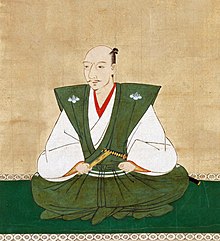
Back Oda Nobunaga AF أودا نوبوناغا Arabic اودا نوبوناجا ARZ Oda Nobunaga AST Oda Nobunaqa AZ Oda Nobunaga BCL Ода Набунага BE Ода Нобунага Bulgarian Oda Nobunaga BS Oda Nobunaga Catalan

Oda Nobunaga (織田 信長, [oda nobɯ(ꜜ)naɡa] ⓘ; 23 June 1534 – 21 June 1582) was a Japanese daimyō and one of the leading figures of the Sengoku and Azuchi-Momoyama periods. He was the Tenka-bito (天下人, lit. 'person under heaven')[a] and regarded as the first "Great Unifier" of Japan. He is sometimes referred as the "Demon Daimyō" and "Demon King of the Sixth Heaven".
Nobunaga was an influential figure in Japanese history and is regarded as one of the three great unifiers of Japan, along with his retainers, Toyotomi Hideyoshi and Tokugawa Ieyasu. Nobunaga paved the foundations for the successful reigns of Hideyoshi and Ieyasu. The period when Nobunaga and Hideyoshi were in power is called the Azuchi–Momoyama period. The name "Azuchi–Momoyama" comes from the fact that Nobunaga's castle, Azuchi Castle, was located in Azuchi, Shiga; while Fushimi Castle, where Hideyoshi lived after his retirement, was located in Momoyama.[5]
Nobunaga was head of the very powerful Oda clan and launched a war against other daimyō to unify Japan in the 1560s. Nobunaga emerged as the most powerful daimyō, overthrowing the nominally ruling shogun Ashikaga Yoshiaki and dissolving the Ashikaga Shogunate in 1573. He conquered most of Honshu by 1580, and defeated the Ikkō-ikki rebels in the 1580s. Nobunaga's rule was noted for innovative military tactics, fostering of free trade, reforms of Japan's civil government, and the start of the Momoyama historical art period, but also for the brutal suppression of those who refused to cooperate or yield to his demands. Nobunaga killed himself during the Honnō-ji Incident in 1582, when his retainer Akechi Mitsuhide ambushed and trapped him in a temple in Kyoto; upon realizing he was surrounded, he committed seppuku. Nobunaga was succeeded by Toyotomi Hideyoshi, who along with Tokugawa Ieyasu completed his war of unification shortly afterward.
- ^ a b 「麒麟がくる」コラム】織田信長はどんどん昇進。信長は官職についてどう考えていたのか (in Japanese). Yahoo News. 6 January 2021. Archived from the original on 7 March 2024. Retrieved 9 March 2024.
- ^ a b NHK大河ドラマ「麒麟がくる」に登場 古い権威を無視し、あえて将軍にならなかった織田信長のリーダー論 (in Japanese). IT Media. 18 January 2020. Archived from the original on 24 May 2022. Retrieved 10 March 2024.
- ^ 織田信長 (in Japanese). Japan Knowledge. Archived from the original on 19 February 2024. Retrieved 10 March 2024.
- ^ Iseki, Eiji (17 November 2022). "「天下人」三好長慶と堺商人の特別な関係 初公開の書状で見えたのは" [The special relationship between the 'Tenkabito' Miyoshi Nagayoshi and the Sakai merchants, as revealed in a letter published for the first time.]. Asahi Shimbun (in Japanese). Tokyo. Retrieved 6 August 2023.
- ^ 安土桃山時代 (in Japanese). Kotobank. Archived from the original on 25 December 2023. Retrieved 9 March 2024.
Cite error: There are <ref group=lower-alpha> tags or {{efn}} templates on this page, but the references will not show without a {{reflist|group=lower-alpha}} template or {{notelist}} template (see the help page).

